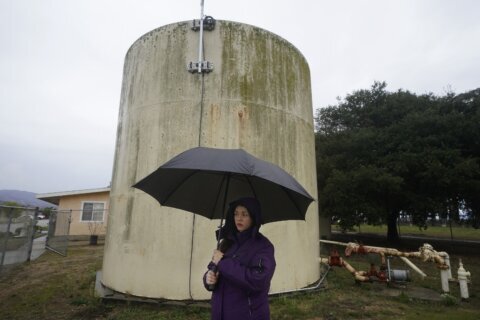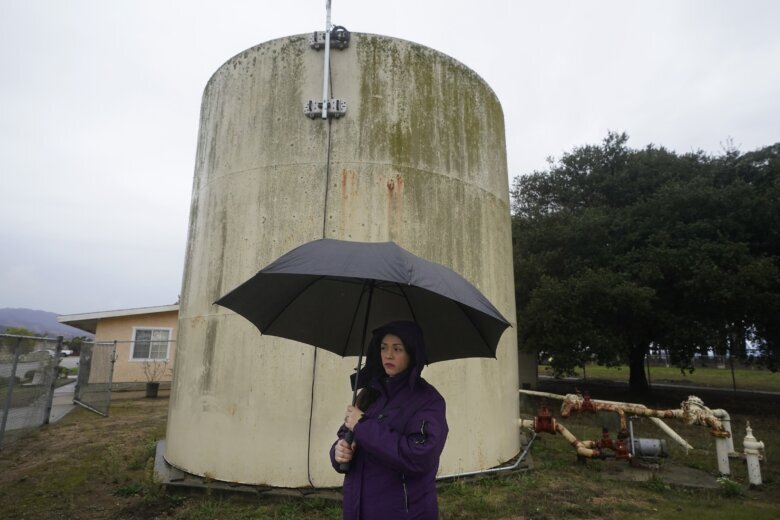
Near fields awash with strawberries and greens, Ileana Miranda and her family pay $72 a month to get water piped into their home in a rural California community — and that’s before they consume a drop.
They pay to bring it from more than a mile away because the groundwater beneath them has been contaminated with nitrates leached into the soil from years of large-scale farming.
Now, the San Jerardo cooperative — where Miranda and 300 others live — and environmental organizations have sued the state, demanding stricter rules about how much fertilizer farmers can use in the hope that the next generation of residents in the community 100 miles (161 kilometers) southeast of San Francisco will have cleaner water.
“We understand crops need these chemicals to grow, but you don’t need to put that much in the groundwater,” said Miranda, who manages the cooperative. “It is essentially poisoning the groundwater that we need to live.”
Some California farming communities have been plagued for years by problems with their drinking water due to nitrates and other contaminants in the groundwater that feeds their wells. Advocates have long pushed to remedy the situation, which disproportionately affects low-income and Latino residents, many who worked in the same fields where farmers are accused of leaving too much nitrate behind.
Nitrogen is in fertilizer because plants depend on it, but can lead to the contamination of drinking water supplies. Much of the nitrate detected in wells today comes from fertilizer applied decades ago to ensure crop size and quality. As a result, researchers say the issue of nitrate-laden drinking water, which can cause a blood disease known as blue baby syndrome in infants and affect pregnant women, will likely persist for decades.
California has been working for years to address the problem through regional water quality control boards and the State Water Resources Control Board. Different approaches have been taken in the Central Valley, which is home to more dairies and tomato farms, and the Central Coast to the west, where strawberries and leafy greens thrive.
Two years ago, the Central Coast Regional Water Quality Control Board issued rules limiting how much fertilizer farmers could apply and protecting areas near streams. The state water board this year put those plans on hold, arguing more consistent standards and scientific review are needed.
The decision drove San Jerardo residents and water quality advocates to take the state to court.
Farmers, meanwhile, filed their own legal action, arguing neither the state nor the regional board fully considered the economic impact of the changes on those responsible for the country’s food supply. Norm Groot, executive director of the Monterey County Farm Bureau, said nitrogen is vital to ensure the size and quality of produce consumed throughout the country, but fertilizer is already being applied more precisely than it was in the past.
“We just can’t sustain our food supply without some sort of nitrogen application,” Groot said. “We now have a lot more science that supports when applications are needed, and how those applications can be measured and metered. We’re not using nearly as much fertilizer as what was done a decade or 30 years ago.”
The Central Coast board’s limits would have forced some county farmers to grow two crops of leafy greens a year instead of three, he said. Pumping out groundwater laden with nitrates to irrigate fields while replacing it with newer water could help improve the situation over time, he said, adding that farmers depend on local drinking water, too.
Edward Ortiz, a spokesperson for the State Water Resources Control Board, declined to comment on the lawsuits but said in an email that the approach taken in the Central Valley has the support of a panel of scientific experts. A second panel, he said, is expected to review both approaches.
The litigation comes as California is stepping up efforts to regulate the use of groundwater after years of drought and with potentially drier winters due to climate change. Farming is a key part of the state’s economy, with strawberries and lettuce bringing in more than $5 billion combined in 2021, agricultural statistics show.
Michael Cahn, irrigation and water resource advisor for University of California, Cooperative Extension, said he’s been working with Central Coast farmers to reduce the nitrogen they leave behind. Strategies include rapid-testing soil before applying fertilizer, improving water management and planting cover crops, he said, but added the problem won’t be resolved quickly.
“The reality is the value of vegetables is so high and a lot of time it is just easer to put more fertilizer and water on than do careful management,” Cahn said. “We have a lot of contaminated groundwater to use so it will take a long time to clean up. People say this could be 50 years in the future.”
Some local communities rely on bottled drinking water due to nitrate levels in groundwater wells, said Brandon Bollinger, senior community advocacy manager at Community Water Center. He said his organization delivers bottled water weekly to about 260 households in the Central Coast, and in one area, nitrate levels were six times what’s deemed safe to drink.
“We like to say water flows toward money and power and in California that generally looks like water flowing toward industrial agriculture,” he said. “We need to have limits and targets and a timeline.”
In San Jerardo, which was founded by farmworkers in the 1970s, people rely solely on groundwater for drinking, bathing and washing. The community’s first well was deemed contaminated in 1990, and the second, a few years later. After a third well went bad, the county got involved and drilled the latest well, said Horacio Amezquita, whose father was among the community’s founding members.
Amezquita said efforts can be made to clean up the water system, but the answer is to not use synthetic fertilizers in the first place. He said he’s still farming in the area, growing cover crops and grains, but doesn’t use fertilizer.
“They’re more interested in having their crops, at their own time, having their schedule at their own time,” Amezquita said. “It’s not a sustainable agriculture.”
Copyright © 2024 The Associated Press. All rights reserved. This material may not be published, broadcast, written or redistributed.







